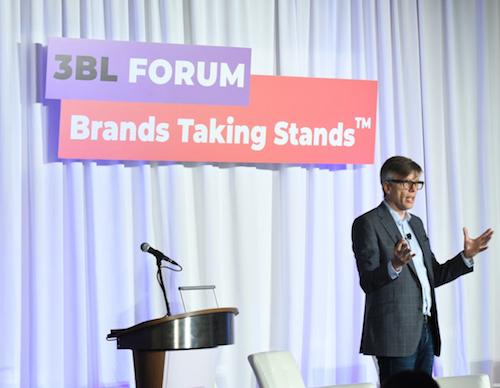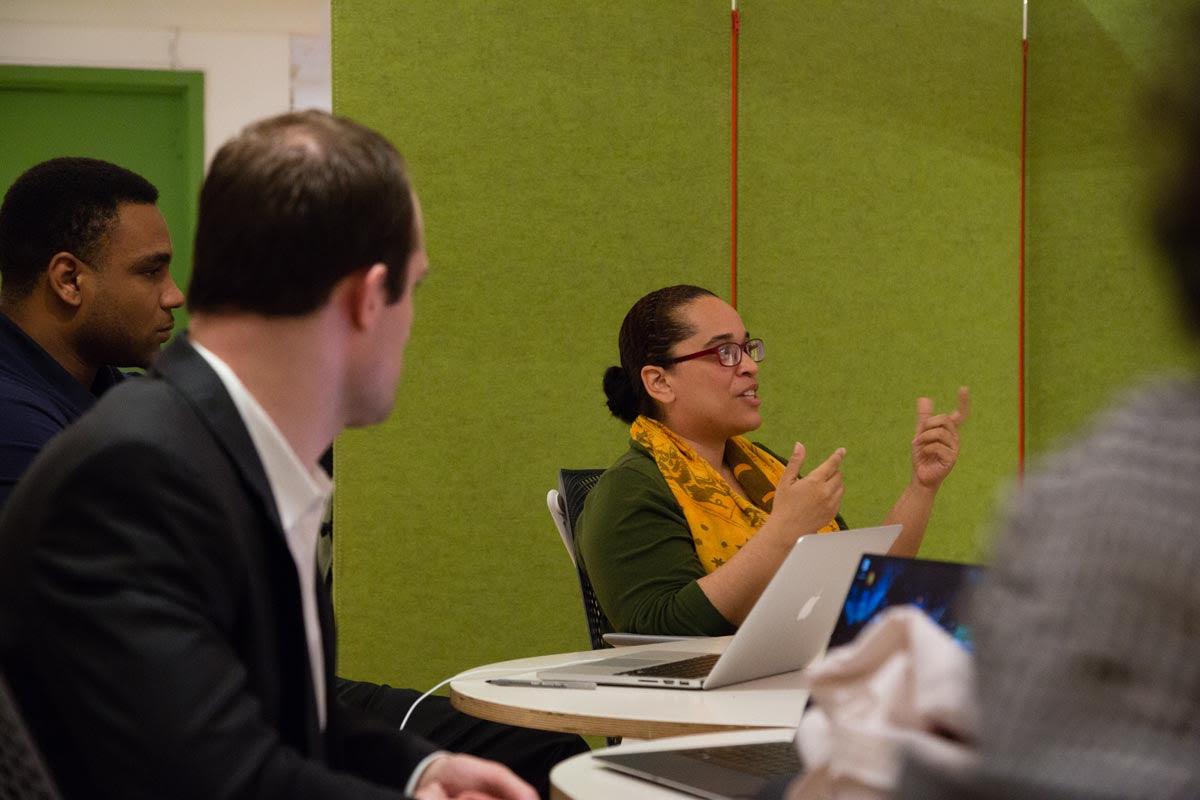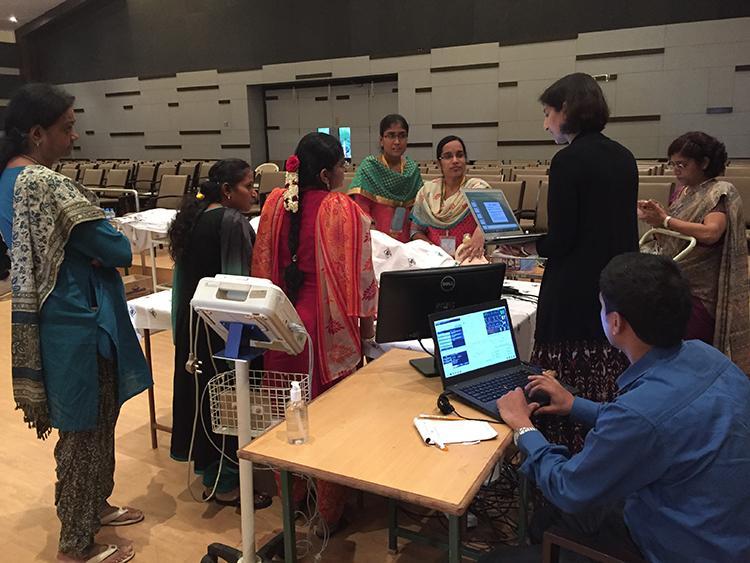Tomorrow: #GenerationForChange Twitter Chat Hosted by Mars, Noon ET


Following COP24? At a time when more governments are turning their backs on environmental policy, the private sector now has a crucial role in accelerating the world’s progress on climate action.
Therefore, you won’t want to miss tomorrow’s Twitter Chat led by a company determined to make a difference on climate action. Join us tomorrow, December 4, at Noon ET/9am PT for a live one-hour #GenerationForChange chat during COP24 in Poland. Mars will be hosting this virtual event.
Joining Mars for tomorrow’s chat are leaders from The Climate Group, EDF, The Nature Conservancy and Oxfam. Participants include:
- Ashley Allen, Climate and Land Senior Manager at Mars (@AshAllen350)
- Elizabeth Sturcken, Managing Director at EDF+Business, Environmental Defense Fund (@esturcken)
- Aditi Sen, Policy Advisor on Climate Change at Oxfam (@urbanwonk_mom)
- Katrine Tilgaard Petersen, Communications Executive at The Climate Group (@ClimateGroup)
- David Cleary, Director of Global Agriculture at The Nature Conservancy (@NatureAg)
During the hour-long discussion, Allen will discuss the company’s various commitments to environmental and social sustainability – including Mars’ long-term plans to lead on climate action, aligning with the United Nations’ Sustainable Development Goals (SDGs) and striving to build a more sustainable supply chain worldwide.
The NGOs rounding out this panel with Allen will offer their ideas on how partnerships can help companies achieve long-term sustainability goals – as well as highlighting why it is critical for the private sector to support the goals of COP24 and the 2015 Paris Climate Agreement.
These steps are urgent, as the world is facing significant challenges. Poverty, water stress and climate change are just a few of the social and environmental issues holding back the potential of people, their communities and businesses worldwide.
To that end, Mars says it is striving to develop new approaches to take on these challenges based on insights the company has learned over the past decade. Mars, which has long focused on the impacts of its direct operations, is now expanding such ambitions across its entire value chain. The clear need for urgent action is why, last year, Mars launched its Sustainable in a Generation Plan – a plan that will allow the company to grow in ways that could benefit people, the planet and its business alike.
Topics that will unfold during chat include:
- Why businesses like Mars should care about COP24 and the 2015 Paris Agreement
- The role companies like Mars have in supporting national climate policy
- The important role partnerships have in achieving long-term sustainability goals
- Barriers that get in the way of supply chains becoming more climate-smart – and ways to overcome them
- How companies can align their progress on the SDGs with their overall climate action goals
- Follow the main participants and the #GenerationForChange hashtag; you may want to use a third-party application like TweetDeck so you can easily follow this one-hour conversation
- Share tweets you think your followers will appreciate
- Follow interesting participants during and after the chat
- Submit questions before tomorrow’s event to promote a more dynamic discussion
- Use the #GenerationForChange hashtag on comments that you want to share with the community
The 1-hour #GenerationForChange chat will touch upon the three key areas of Mars’ plan: a healthy planet, thriving people and nourishing wellbeing.
WHEN: Tuesday, December 4, at Noon EST / 9am PST / 6pm CET.
WHERE: Join the conversation on Twitter, or on a third-party platform such as TweetDeck, by following #GenerationForChange
New to our Twitter chats? Don’t worry! Read this.
Look Up: Flying Cars Are Coming Sooner Than You Think!


Since the time of the 1960’s cartoon family, The Jetsons, it seems the promise of flying cars has been just around the corner, but making this a reality has always proven elusive.
In fact the dream was set way before then going as far back as 1842, when according to The Economist, a British lace maker filed a patent for an “Aerial steam carriage” - an overly ambitious and of course unsuccessful innovation.
There have of course been several successful attempts at building flying cars in the past, matched with just as many commercial flops. Efforts to blend fixed wing aircraft with cars produced neither a great plane nor a practical car; on top of which, the need for runways proved a major impediment to their practicality. Hence the idea of flying cars has been a rich person’s hobby at best.
However, with burgeoning autonomous vehicle technology, and advances in electric-powered drone development, these days, there’s a lot of investment dollars going into passenger drones, and maybe “flying cars” really are just around the corner today.
Who owns this future seems to be up for grabs. At the moment passenger drones are developmental projects by companies spanning established industries such as aerospace, automobile and technology sectors - Airbus, Toyota, Google and Uber are all household names involved in trying to carve out a piece of the action in this space. Quite possibly, partnerships across these established industry sectors may win the day.
For example, Audi and Airbus demonstrated a joint robo-taxi service (called Pop.Up Next) this month at Drone Week in Amsterdam. Forbes reported the project combines an aerial drone and a modular electric car, whereby a detachable passenger pod can be transported by drone autonomously to a certain location and deposited upon an electric car chassis, for the “last mile” transportation. Transportation journalist Liane Yvkoff says Audi has been testing the system using a 1:4 scale model in South America, and demonstrated this month that the drone could successfully deposit the passenger pod onto the electric car. Audi says it is convinced flying taxis are on their way.
This is one of many passenger drone concepts. The technology underpinning them all, however, is ever improving battery technology which can now provide sufficient energy density to power the electric rotors. This in turn permits vertical take-off and landing (or VTOL), and enables enough flying time to make passenger drones a useful form of transport. There are a number of working prototypes today which offer proof of concept.
As such, the technological pieces already more or less fit together to make passenger drones a likely part of our transportation future. Additionally the social driver that has so many big companies excited is that since more people live in ever increasingly dense urban environments, drones will be necessary to alleviate the existential and worsening gridlock faced by ground transportation options.
But do the economics of passenger drones make sense, and importantly, is there a business case?
In March this year, the investment company ARK Invest - an organization which focuses on large scale investment opportunities resulting from technological innovations - published research on what they call “air taxis” or eVTOLs, and they believe autonomous passenger drones are absolutely in our future.
Looking at a scenario of getting from Midtown Manhattan to JFK airport, ARK Invest’s analysis suggests that the journey would take just 18 minutes by drone - a quarter of the time a traditional taxi journey would take - and would cost about 74 dollars, which they say is a small premium over a typical 65 dollar taxi ride.
This sounds surprisingly cost effective, but ARK Invest details costs are controlled by various factors such as the likely low maintenance costs of electric motors, limited need for special infrastructure, low energy costs (compared with fossil fuel), and wage savings since these vehicles would be pilotless. They are sufficiently bullish to think air taxi services could be commercially available in around 5 years.
There are of course still significant obstacles still to overcome. Earlier this year, The Economist pointed out “sense and avoid” equipment required to prevent airborne collisions does not yet exist, though they say such systems are under development by NASA and other organizations.
On top of that, TechCrunch identifies that developing comprehensive regulations will likely be an impediment too, citing that in the United States, the FAA has been slow to address the drone industries’ call for them. Perhaps it's not surprising regulatory issues are not yet resolved; after all, the regulatory conundrum is far from resolved for autonomous cars too, so imagine regulating vehicles that move in a third dimension.
Imagine too, the potential social resistance in the adoption of this technology. Will people trust the technology to get on board a pilotless flying drone? It’s one thing if an autonomous car develops a technical problem; it can be programmed to pull over, but what is the escape plan with a pilotless drone that runs into difficulties?
No doubt technological and regulatory issues will be sorted out, and all innovations have their early adopters. But another interesting question remains - are passenger drones a particularly environmentally sustainable way of solving the mass movement of people in dense urban areas?
ARK Invest calculates that a Tesla Model S operates at 0.27 kWh per mile, whereas an air taxi will likely use 1.16 kWh per mile - more than four times as much energy. In fact the air taxi is closer in energy use to Tesla’s forthcoming semi truck - which will use 1.55 kWh per mile - than it is to Tesla’s passenger EV.
For further perspective however, according to UC-San Diego research, the equivalent energy cost of a moving a 12 mpg Hummer is 3.05 kWh per mile - so the air taxi beats the Hummer easily (though that’s arguably a low bar) but it doesn’t hold a candle to a 50 mpg Prius which uses the equivalent energy of 0.73 kWh per mile. In conclusion, air taxis are within a reasonable range of energy use.
But it would be hard to advocate passenger drones on the basis of energy use as the most sustainable way of moving the masses around dense urban environments. Electric scooters would do a much better job of alleviating urban congestion at a mere fraction of the energy cost. However, as a substitute for getting a traditional taxi to the airport, or an option for children or the elderly who can’t otherwise get themselves around, the technology would no doubt have its place. Certainly, plenty of big transportation, aerospace and tech companies are making a bet on it.
Image credit: Pierre Lannes/Flickr
Brands Taking Stands: A Movement, Not a Moment


As a journalist, I’ve always searched out cultural trends as I saw them developing, in a constant search for “what’s next.” This is especially true of the Brands Taking Stands movement.
“What’s next” is, of course, of major importance to business. Looking ahead to map out strategy is critical to continued success. But which trends are the right ones with which to align future plans? Which ones will matter months, even years, down the line?
What business strategists, and those of us who report on their projections, are on the lookout for is a trend that becomes much more than a cultural snapshot. We’re talking about a defining idea of the zeitgeist that carries large, long-lasting consequences for society as well as for business—in a phrase, a movement--not a moment.
In this newsletter, we’ve argued since its beginning that Brands Taking Stands is such an idea. Now, we have some numbers to back up our claim about this development in corporate activism. New research finds that eight-out-of-10 corporate leaders believe companies have an obligation to speak out on environmental, social and governance (ESG) issues. That’s according to a survey on brand advocacy conducted by GlobeScan and 3BL Media.
Results from the survey were debuted last month at the 3BL Forum. The report defines the Brands Taking Stands movement succinctly: “A growing roster of Blue Chip companies are using their powerful voices to urge continued U.S. support of the Paris Climate Agreement, to strengthen gun control laws, to fight immigration laws that would negatively impact Dreamers, to champion diversity and inclusion, and to protect LGBTQ rights, among other hot-button and often political issues.”
The future workforce and brand reputation are revealed as the two principle reasons for the movement. “The tightening labor market, specifically competitive pressure for companies to recruit and retain talent, is a key driver of the Brands Taking Stands movement, followed by efforts to protect and enhance corporate reputation.”
- 82 percent of respondents said it is necessary for companies today to advocate for or take a stand on ESG issues.
- 62 percent felt that advocacy by CEOs, rather than by the company more broadly, will increase in the next 18 months.
- When asked to specify the three highest priorities for their organizations over the next 18 months, top responses were brand values, climate and environment, and diversity and inclusion.
- Motivators for companies to take stands on ESG topics were to 1) enhance their reputation, 2) show a commitment beyond profit, and to 3) meet employee expectations.
- Benefits of speaking out are 1) personnel recruitment, 2) employee retention and 3) brand equity.
“It’s early days for this movement,” said Eric Whan, a GlobeScan director. “Ben & Jerry’s, Tom’s of Maine and Patagonia and others have been doing this for a while. Now, others are finding that it is in their own interest and that of their stakeholders to take a position rather than ducking.”
In a way, Brands Taking Stands is one of those “trends” that we have been reporting on at 3BL Media since 2009. The clients whose messages we have distributed and about whose news we have published original reporting come to us with missions, principles, values, and initiatives—all built on taking positions beyond those limited to bottom-line results. The concept may be said to have burst into visibility within the larger culture in 2015-16, when hundreds of companies took stances on matters of public policy.
The movement picked up speed exponentially in 2018 (with efforts such as CEO Action for Diversity & Inclusion). This year started off with a bang when Andrew Ross Sorkin of the New York Times “DealBook,” characterized the public letter from BlackRock’s Larry Fink calling on companies to serve a social purpose “a watershed moment on Wall Street, one that raises all sorts of questions about the very nature of capitalism.”
As Steve Rendle, CEO of VF Corporation and CR Magazine’s Responsible CEO of the Year: Public Company, put it at our 2018 3BL Forum, “Consumers are starting to make decisions on the brands that they interact with based on what the company stands for -- not necessarily what you make, but what is the value you’re providing to the community and the world.”
If we trace the arc of this still-developing movement from those epic January statements to this year-end research, it’s clear that Brands Taking Stands is a movement and one on a roll.
Get used to it.
Stay in touch with the latest developments in corporate activism with our Brands Taking Stands newsletter.
Image credit: GlobeScan co-CEO Chris Coulter onstage at 3BL Forum 2018 discussing the future of business leadership
Advancing the Circular Economy via Product-Service Systems


Today, the economic models of many countries are mostly built on the premise of ‘take-make-consume-and-dispose’ patterns of growth. Business and industry have customarily followed such a linear model that assumes that resources are abundant, available and cheap to dispose of. Every product is usually bound to reach its ‘end of life’ at some stage or another. When products are no longer useable or required, they are usually discarded as waste.
Several academic commentators claim that product-service systems (PSS) are moving society towards a resource‐efficient, circular economy as the sale of tangible products may also include service systems such as repair and maintenance, updates and upgrades and disposal‐services such as recycling. In a nutshell, PSS involves selling physical products as well as the provision of after-sales services so that businesses are capable of satisfying consumers’ demands.
PSS providers are in a position to design "need‐fulfillment" systems with lower impacts to the environment, by either replacing an alternative product‐service mix or by influencing the customers’ activities to become more eco‐efficient. For-profit organizations have an incentive to prolong the service life of their products and to make them as cost‐ and material‐efficient as possible.
Moreover, PSSs would typically extend beyond purchase, affecting the use and disposal of resources. Hence, these systems could lead to the minimization of material flows in the economy whilst maximizing the businesses’ service output and their users’ satisfaction. There are three types of PSSs that prescribe different product service components and ownership packages:
(a) a product‐PSS that adds extra services, but the ownership of the product(s) is transferred to the consumer(s);
(b) the results‐PSSs that would involve both parties agreeing to achieve target results, as they recast product(s) as utilized materials;
(c) in use‐PSSs, the provider(s) lease, share or pool their product(s); however, they retain the ownership of the product(s).
For instance, Philips, a diversified technology company utilizes the use‐PSS approach, as it provides a lighting service to customers and is responsible for its technology risk. The Dutch company installs its lighting equipment (including street lighting), maintains it, and ensures that it runs for a very long time. Eventually, it reclaims back its equipment when it is the right time to recycle materials. This property rights are distributed amongst Philips and its clients, over the lifetime of the products.
Philips has recognized an untapped opportunity to retain ownership of its products, as it has committed itself to dispose of the infrastructure and its constituent parts at their end of life. At the same time, customers (including the government) do not have to pay high upfront costs for their lighting equipment. Interestingly, Philips is also adopting a similar PSS within health care environments where it has established leasing relationships with clients for its medical infrastructure. Again, the company will eventually reclaim back its equipment and upgrades it when necessary. When the medical equipment is refurbished with the state‐of‐the art technology, the multinational firm will reuse it for another customer; it provides a warranty and guarantees its products as new.
The idea of shared ownership is conspicuous with the results‐ and use‐PSSs. These systems have led to upstream effects (through sustainable design) and increased throughput. PSSs are sustainable in the long run, as they reduce the use of finite resources, and result in less externalities, in terms of waste and emissions. PSSs are intended to reduce the use of finite resources.
Everyone has a responsibility to bear for the products’ disposal at their end of the life. There are opportunities as well as threats facing our organizations’ and environmental sustainability in the foreseeable future. The main challenge is creating the right environment where businesses collaborate together to benefit from resource efficiency and increased throughput. Indeed, PSSs can be facilitated through stakeholder engagement and the formation of clusters at supply chain level. The development of Eco Industrial Parks (EIPs) would help businesses turn their unwanted externalities into useable materials for others. Therefore, local institutions and governments are encouraged to support PSSs as they maximize the functioning of global ecosystems.
Parts of this contribution appeared in an academic paper that was recently accepted by Sustainable Development (Wiley).
Image credit: Peter Kaminski/Flickr
How Mosaic Is Working to Help Feed a Growing and Hungry World


The demand for food around the world shows no sign of slowing. The number of undernourished people in the world has been on the rise since 2014, reaching an estimated 821 million people in 2017. The UN estimates that the global population will reach 9.7 billion by 2050. To feed that many people, the UN’s Food and Agriculture Organisation (FAO), estimates that food production and agricultural productivity must increase by 70 percent by 2050.
The FAO estimates that just over a third of the potential land worldwide suitable for crop production is being used, which indicates some scope for further expansion of agricultural land. But a number of forces limit that expansion. Among these are environmental considerations; for example, bringing new land into production results in greenhouse gas emissions and disruption of ecosystems. Another consideration is shortage of suitable land, due to soils, climates, accessibility, the need to preserve forests, policies and other factors.
Pressure to raise productivity
To help fill this growing need for nutritious food, fiber and fuel, farmers need to wring as much productivity as possible from every available acre and hectare. Around the world, yields continue to rise as farmers push their productivity forward – which is a positive trend. However, to continue at this pace, farmers know nutrients taken from the soil need to be replenished.
This is the challenge that Mosaic is helping to tackle. Mosaic’s core business—producing and distributing potash and phosphate fertilizers—helps farmers maintain healthy soils, which in turn contributes to continued productive harvests. Potash is a plant’s main source of potassium. It is one of the four primary nutrients required for plant growth along with nitrogen, phosphate and sulfur. It is used as a highly effective fertilizer routinely in the major food and crop growing regions especially China, Brazil and North America.
Mosaic’s mission—to help the world grow the food it needs—is “embedded in everything we do,” Corrine Ricard, senior vice president, commercial for Mosaic, told TriplePundit recently. “It remains as relevant today as it was when Mosaic was formed 14 years ago.”
Free trade and open access to global agricultural markets are critical to food security, says Ricard. “Farmers around the world depend on Mosaic, and other suppliers, to deliver the crop inputs when and where they are needed, and at an affordable price,” Ricard told us. “In our business, the impact of free trade restrictions and market access disruptions can be felt from mine to market. The simple fact is this: Fertilizer accounts for more than half of all crop yields. This means that constricted access to fertilizer goes well beyond corporate profitability – farmer livelihood, yields and food security are ultimately at risk. “
Mosaic works closely with industry and trade associations to ensure the facts are understood and that those in a position to influence trade discussions and decisions are kept well informed on the topic, Ricard says.
Rising global demand for fertilizer
Over the past three years, there has been growing concern from investors and market analysts over significant new potash and phosphates supply coming into the market and how this will balance with global demand, Ricard told 3p.
“The reality is that this market perception of new supply has yet to materialize. Global demand continues to increase each year and new production has been slow to come to market.”
According to Ricard, “Mosaic is well positioned to take advantage of the increase in demand, and for the potential expansion into new fertilizer markets in the years ahead. We are a highly efficient, responsible and cost competitive global supplier, and are confident we can continue serve customers well while growing our business for the long-term.”
Providing the world’s food sustainably
Responsible operations in crop nutrient production are a high priority for Mosaic. The quest for global food security is complex, impacted not only by rapid world population growth but also by the expanding middle class (the Brookings Institution reports that half the world is now middle class or wealthier) and the energy crisis. Access to affordable, reliable, sustainable and modern energy is central to food security. It’s clear that agricultural production must increase—but it must do so sustainably.
“We work with our customers to promote the principles of balanced crop nutrition and the 4Rs Nutrient Stewardship Framework: Applying the right source of fertilizer at the right rate, right time and right place,” she says.
Tapping into innovative products
Demand for crop nutrients remains strong, with the total global demand for fertilizers expected to reach some 189 million metric tons in 2017/2018. This will only rise as the global population grows.
“That is why Mosaic is committed to delivering innovative fertilizer products farmers need to help maximize yields and feed a growing population,” Ricard told us. “We focus on developing innovative premium products that help our customers and their growers achieve high yields. And we continue to operate responsibly, working to keep our people and our natural environment safe.”
One such product is MicroEssentials, developed using Fusion technology, which combines key nutrients (N, P, S, Zn) into a single nutritionally balanced granule. As the leading sulfur-enhanced phosphate product on the market, Mosaic reports that MicroEssentials delivers uniform nutrient distribution across the field, increases nutrient uptake into the plant and provides two forms of sulfur (elemental and sulfate sulfur) for season-long sulfur availability and is effective across a variety of cropping systems and soil conditions.
“MicroEssentials has been a success story for Mosaic, delivering value for everyone involved, from Mosaic to the retailer to the farmer,” Ricard says.
Serving the Brazilian market
Mosaic’s aim is to serve the world’s most promising agricultural areas. This includes Brazil, with one of the biggest agricultural markets in the world. Brazil’s farm economy has grown at remarkable rates over the past two decades, and that growth continues today. Fertilizer consumption has grown at a five percent compounded rate this decade, outpacing growth in every other major agriculture region, according to Mosaic.
Mosaic expects that growth to continue, Ricard says, as more of the Cerrado, the vast savanna ecoregion of Brazil, comes into production and as the country’s farmers, who are prospering today, seek to drive their yields higher.
To support its mission to serve Brazil’s agriculture industry, in 2018 Mosaic completed its acquisition of Vale Fertilizantes, a Brazilian fertilizer company, making Mosaic the leading fertilizer production and distribution company in Brazil. This follows the acquisition in 2014 of Archer Daniels Midland Company (ADM)’s fertilizer distribution business in Brazil and Paraguay.
“Mosaic has invested heavily in Brazil,” says Ricard. “Our Vale Fertilizantes acquisition, together with our earlier ADM acquisition, is the cornerstone of our Brazil growth strategy. We are now the largest fertilizer producer in an extremely promising agricultural market.”
Image: Pixabay
Impact Finance: Defining Skills for Career Success


Earlier this fall, two dozen investment professionals, finance professors, and MBA students and alums huddled in a conference room above Wall Street for a critical discussion: what is the skill set needed for a career in finance for impact?
The Bard MBA in Sustainability program, based in New York City, recently launched a new focus area in impact finance. The mission is to train a new generation of investment professionals. Their goal is to move trillions of dollars out of investments that are reinforcing runaway climate change, water and air pollution, and waves of environmental refugees and into projects that can build a regenerative future.
Two examples: Sustainable business pioneer and Bard MBA Professor Hunter Lovins recently helped launch a truly fossil free exchange-traded fund (ETF), through her company Change Finance. Since its inception, the fund has been outperforming the S&P 500. Randy Strickland teaches the impact finance course within the MBA program, bringing insights from ESG (environment, social and governance) investing at scale through his day job in as a Director at Cornerstone Capital. The new Focus Area in Impact Finance is preparing students for these kinds of careers leading the transformation of conventional finance.
Exciting projects and employment opportunities in the space are emerging. But what skills should be taught?
Where the Jobs Are
At the “curricular design charette” the participants first brainstormed the sectors where impact finance jobs are beginning to show up. The list, part of which is shown below, was long with some surprising opportunities. These sectors include:- Asset managers
- Bond issuers, private and government
- Investor Relations
- Non-profit engagement organizations
- Private equity
- Rating agencies
- Social venture accelerators
Hard Skills, Soft Skills
The debate then turned to the specific quantitative competencies that were required on both the finance and the impact sides-- along with the general suite of soft MBA skills that employers look for. Bard MBA’s are already very well trained in evaluating and measuring social and environmental impact: this topic lies at the very core of the MBA in Sustainability degree.On the finance side, participants agreed that students need to to see the “big picture” of asset allocation, building a portfolio across asset classes rather than gaining expertise in a narrow asset class. The overarching goal is to change the behavior of the big asset managers, and to do that, students need to be able to speak the language that MBA’s trained 30 years ago, and now running the industry, will understand. At the same time, graduates need the best modern tools around impact assessment and risk management.
To get there, the Bard MBA Focus Area requires a 9-credit classroom sequence: (1) Accounting and the Integrated Bottom Line, (2) Finance for Sustainability (covering core corporate finance topics with a sustainability lens) and (3) a dedicated course in impact finance called ImpactLab. In addition, there are 15 credits of experientially-based finance learning, discussed more below.
Following the charette, the Bard MBA put together a list of the principle “hard finance skills” expected of Bard graduates from the three courses. The team is currently reviewing the list to consider additions and subtractions.
Experience, Experience, Experience
A primary employment challenge the group identified was the fact that Bard MBA’s were not following the typical “apprenticeship” routes into finance. Instead, they were often looking to make lateral moves into impact investing from existing careers outside the industry. The solution: gain maximum resume building experience while in the MBA.Bard MBA students in the first year take a two-semester course in sustainability consulting called NYCLab. This course, not offered at any other MBA program, has teams work on sustainability projects for real world clients like NASDAQ, UBS, Unilever, Eileen Fisher, Jet Blue and Siemen’s Wind. Impact Finance Focus Area students thus start their MBA program gaining a unique, deep immersion helping solving real impact finance issues.
In the final year, Bard MBA’s complete a nine-credit, individually mentored capstone. In this course, students have the opportunity to consult, intern and develop career-specific professional networks. Through both NYCLab and a finance-oriented capstone, as well as case competitions and other avenues, students gain the substantial experience needed to help them enter the world of impact finance.
Change Finance, Change the World
Elysa Hammond, Vice President of Sustainability at Clif Bar, says that to achieve sustainability, we need to transform four systems: food, water, energy and finance. And to transform the first three, we need to transform the fourth. This reality is motivating the Bard MBA Community to co-create the education that future investment professionals need now to take finance for impact to scale. The key is to combine cutting edge academic training with substantive real world experience, opening the door to careers moving capital from investments that are bad for people and planet towards projects that are doing good for the future.Image credit: Pete Mauney
Using Technology to Fight Maternal Mortality Worldwide


At the Thanthai Periyar Government Headquarters Hospital in the southern Indian state of Tamil Nadu, 40 women may be in labor at any given time with a single doctor on a 24-hour shift attending to all of the patients. The ward is packed and hectic. The doctor is tired and working under immense pressure. Lives are on the line.
How can one doctor keep track of every soon-to-be mother, detect any dangerous change in vital signs, and intervene quickly to prevent complications— or worse, death?
Dr. Narmadha Kuppuswami, an Illinois-based obstetrician and gynecologist with nearly 40 years of experience, may have the answer.
As the founder and project coordinator of the Women’s Obstetrical Neonatal Death Evaluation & Reduction (WONDER) Project, Kuppuswami and her team are working with HP’s Global Healthcare Solutions group to develop tools and protocols to reduce maternal mortality.
Kuppuswami wants to develop a framework for a global system of cloud-based electronic birthing centers, where highly trained obstetricians can guide skilled maternal care no matter where the patient is located. They’re piloting the project in India, and have multiple upcoming programs in the United States, as well as possible programs in East Africa and the Middle East.
“Now that I’ve gathered knowledge and experience, I have to put it to use to see how we can reduce maternal mortality in India — and the world,” she says.
A global issue, a technological solution
According to the World Health Organization (WHO), about 830 women die every day from preventable causes related to pregnancy and childbirth. For example, while 99 percent of all maternal deaths occur in developing countries, even in the United States, maternal mortality rates are on the rise, and more American women die of pregnancy-related complications than in any other developed country. The issue is a global challenge around the world.
WHO estimates that three-quarters of all these deaths are caused by severe bleeding, infections, pre-eclampsia and eclampsia (dangerously high blood pressure) in the third trimester, complications from delivery and unsafe abortion. But the risks of childbirth can be mitigated with the help of technology, accurate data collection and easy-to-implement, common sense protocols.
“The goal is to put the right hardware and software in the hands of clinicians, so that they can provide the best possible care — as well as patients, so that important data can be collected even outside of the clinical setting,” says Frances Ayalasomayajula, population health worldwide lead at HP Global Healthcare Solutions.
“In the context of maternal mortality, we have a huge opportunity to reduce preventable deaths,” she adds.
Identifying risks in real time
At the heart of the WONDER Project is an electronic health record (EHR) system featuring a color-coded vital signs chart that helps doctors and nurses quickly identify patients who are at risk of acute complications.
To make care more efficient, the WONDER team places a wearable biometric device on patients that checks their pulse, blood pressure, oxygen saturation level and respiratory rate, and automatically updates the WONDER EHR system via Bluetooth. An application built by the WONDER team and installed on HP notebooks and tablets pulls the data directly from the biometric device and transmits it to HP Healthcare Edition displays at nurses’ stations.
The WONDER EHR system then uses three color codes –– green, yellow and red –– to indicate whether changes in vital signs, pulse rate, blood pressure and temperature are deemed normal, at risk or dangerous. If the patients’ vitals change for the worse, an alarm sounds and the system provides possible diagnosis and treatment guidelines.
"When more than two values fall on yellow or one value falls on red, it gives an alarm, which indicates an acute emergency requiring immediate medical attention,” explains Kuppuswami. "That’s the basis of WONDER.”
Instead of darting from one patient to another, unsure of whose conditions are stable and who might be teetering on the brink, a doctor caring for several dozen women in labor at a hospital can get a real-time view of who needs medical attention.
"Once the alert comes, the patient should be able to get treatment within one hour,” says Kuppuswami. "That is the target."
WONDER in action
At the Thanthai Periyar Government Headquarters Hospital, where the WONDER Project is in full swing, a patient was recovering in the postpartum unit two days after she suffered a stillbirth. Her biometric device registered a high blood pressure reading, which triggered the red alert and sounded an alarm from the HP monitors. Doctors leapt into action, treating her with hypertensives to bring down her blood pressure.
At another Indian hospital, a woman checked in two days before her scheduled delivery date. On the morning of her second day there, she developed pre-eclampsia, and the alert system quickly notified the doctors. She was given medications and told to rest, but her blood pressure remained high. Doctors got the alert again and gave her an injection of magnesium sulphate. They determined a natural birth would be too risky, so she was taken to an operating room for a caesarean section. Today, both mother and daughter are healthy.
"Normally, they don’t check blood pressure on a routine basis, because there are so many patients,” says Kuppuswami. “The only reason we picked this up was because of the routine monitoring of blood pressure.” Kuppuswami adds that if the problem had gone undetected, the patient could have experienced a serious complication like cardiac arrest or eclampsia, which can cause life-threatening seizures.
Along with individual success stories like these, the WONDER Project is showing promising results on a broader scale. Kuppuswami says there’s been a significant decrease in transfers from the three participating general hospitals to medical college hospitals, where patients experiencing complications are sent for more sophisticated treatment. She says this suggests a reduction in the overall number of complications, possibly thanks to the alert system.
Expanding access to maternal healthcare
But what about the women in far-flung places who can’t even make it to the hospital? Hours of travel along bumpy, unpaved roads may be their only connection to a proper health facility, and they can’t afford to waste that time when an emergency strikes.
To address these challenges, the WONDER team has expanded the project to several primary health care centers in rural locations in India. To raise awareness, they’ve produced and distributed educational videos about pregnancy- and childbirth- related complications.
“All of these recordings will be done in local languages and in simple terms, without using medical terminology,” Kuppuswami says. “Patients will understand the seriousness of problems such as anemia and sepsis, pre-eclampsia and eclampsia, and the warning signs.”
In addition, health care workers meet patients in their villages to collect data on their vital signs and alert women who need medical care before their situation becomes urgent. Meanwhile, the information is stored on HP tablets, and workers upload it to a server once a network connection is available, creating an electronic record for future reference.
This is the first step toward Kuppuswami’s vision of establishing electronic birthing centers around the world. She envisions hospital labor wards that are connected to primary health centers in remote areas — similar to electronic intensive care units, which use telecommunications technology to diagnose and treat patients remotely.
Obstetricians at the hospitals would receive WONDER EHR data from patients within eight seconds thanks to the cloud-based system. They would then provide medical guidance to care workers out in the field, even arranging to airlift patients if necessary.
“I want to take this global,” says Kuppuswami. “The electronic birthing center could be anywhere.”
Previously published on HP's Garage Blog and 3BL Media news.
Kickstarter’s New Features Put Sustainability Top-of-Mind for Creators


This morning, Kickstarter unveiled new features that will help creators evaluate and reduce the environmental impact of their products at the earliest stages. Kickstarter teamed up with EDF Climate Corps to develop an information hub called the Environmental Resource Center, as well as a space where project creators are asked to publicly commit to environmental practices.
The new Resource Center – developed by EDF Climate Corps fellow Alexandra Criscuolo – provides a tangible starting point for creators. It’s a one-stop-shop of environmental resources, case studies and best practices from industry experts on how to assess, adopt and communicate sustainability efforts.
As a crowdfunding platform, Kickstarter gives people the ability to turn a creative idea into a tangible product - anything from games and art to design and technology - thanks to the direct support of others. But as you can imagine, a lot more goes into turning an idea into a product than just raising funds.
Creators have to make decisions about design, manufacturing, production, marketing, etc – most of which must be determined in the early stages of development. Unfortunately, sustainability is not usually top-of-mind for creators during those initial stages.
But starting today, these new features could change that.
What are these features?
An “Environmental Commitments” section has been added to all project pages within Kickstarter’s Design & Tech category, and plans are underway to expand it across more categories.
Creators can commit to reducing their environmental impact in key areas: long-lasting design, reusability and recyclability, sustainable materials, environmentally friendly factories, and sustainable fulfillment and distribution. Now, potential financial backers visiting these product pages will be able to see whether a creator has chosen to commit to more sustainable practices.
This is an amazing step in helping the hundreds of thousands of creators who come to Kickstarter commit to making sustainable products and communicate this effort to their potential supporters. But, even if creators want to make commitments, they might not have the environmental tools needed to assess the environmental impact associated with the manufacturing and shipping of their physical products. That’s where the Environmental Resource Center comes in.
The Resource Center helps turn a commitment into action. For example, if a creator is committing to better incorporate long-lasting design through modular design principles, one tip that the Resource Center recommends is to consider how the product can be repaired if it breaks: “Make disassembly easy by choosing screws to bind parts instead of glue.”
Why are they so important for supply chains?
- Reach.
Since 2009, 154,000 projects have been funded through Kickstarter’s platform, attracting millions of supporters. Some of these projects blossom into companies of their own, like Kickstarter alumni Allbirds and Oculus.And the influence of these features extends beyond just the creators on the platform. The millions of people across the world who are part of Kickstarter’s network will now see these environmental commitments and voice their support with financial backing. - Timing.
As a launching pad for products and companies, Kickstarter can influence creators at the early planning stages.Thinking about commitments at the start will help creators embed sustainability into the core foundation of their business or product – something more customers are demanding - as opposed to integrating it later on, which is not easy and sometimes less impactful. - Creativity.
Kickstarter has signaled to the rest of the industry that there are innovative approaches to reducing the impact of supply chains.This kind of creative, highly customized thinking, is what’s needed to reduce Scope 3 emissions – carbon emissions associated with supply chain and indirect activities. By examining principle activities, considering core competencies and then delivering a customer-centered resource to empower change, Kickstarter has reduced their downstream Scope 3 emissions in a big way.
Kickstarter is the world’s largest funding platform for creative projects, and with these new features, it could soon become the world’s largest funding platform for creative, sustainable products.
Previously posted on EDF+Business and 3BL Media news.
Medellín, Latin America’s Leading Smart City


Is your company or NGO looking to open a regional office in Latin America, but you're not sure which of the region’s dynamic cities makes the most sense for your employees and operations?
If your organization wants to send a message that it respects the region’s drive to grow sustainably, while taking an active role in what the future could hold for Latin America’s estimated 640 million people, there is one clear choice: Medellín, Colombia’s second largest city.
Forget that show on Netflix and the city’s troubled past; Pablo Escobar’s been dead for 25 years, and Medellín’s citizens are moving forward at a rapid pace that would make many cities in the “developed world” blush. Many Colombians, along with the foreign travelers who keep visiting the country in increasing numbers, will be quick to say this city home to 2.5 million people and the capital of the Department of Antioquia is their favorite city south of the Panama Canal. The reason? Time and time again, you’ll hear the word “vibe” being attributed to Medellín.
There are several underlying reasons that explain Medellín’s vibe while contributing to its emergence as one of the world’s leading “smart cities.” Medellín has had no shortage of awards that herald the city’s innovative approach towards politics, social innovation and sustainability. The city’s leadership in the following areas only tell part of the story behind Medellín’s transformation.
Education
Home to over 30 universities and leading technology centers, Medellín has been on a public education binge this century. The expansion of the city’s schools is especially noteworthy for where many of the newer ones are located: in the poorer neighborhoods of Medellín. The same can be said for many of the city’s “library parks,” which are exactly that: a library building surrounded by plenty of green space for public use.
One civic leader responsible for this emphasis on education has been Sergio Fajardo, mayor of Medellín from 2004-2007 and then Governor of Antioquia from 2012 to 2016. In an interview with Americas Quarterly during the early days of his governorship, Fajardo explained his administration’s approach was to build “the most beautiful for the most needy” and that the emphasis on building top notch facilities was “because the first step in education is having a dignified space in which to learn.”
While proponents of smart cities tout the need to groom efficient, sustainable and cutting-edge urban environments in order to meet the needs of a 21st century workforce, the strategy in Medellín has been to go a step further: its civic leaders and community groups have believed cities need to be designed so they are a place in which people will find dignity.
Environment
Those aforementioned library parks are just one reason why Medellín is a poster child for the Sustainable Development Goals (SDGs), notably Goal 11: Sustainable Cities and Communities. Not that it’s been easy: the city is wedged in a valley surrounding by mountains, so the only way for the city to grow is upward. That growth, however, has only occurred somewhat in high-rises – much of the growth is skyward in the surrounding mountains.
One project that is simultaneously taking on challenges including suburban sprawl, erosion and even food insecurity is Medellín’s El Cinturon Verde Metropolitano, or metropolitan greenbelt. A work in progress, this greenbelt will be almost 50 miles long (75 kilometers), with plans including community gardens, recreational spaces, hiking trails and improved housing for some of the city’s poorest residents. The project is being built in four phases and seeks a completion date by 2030.
Public Health
Home to several of South America’s top-ranked hospitals, Medellín has long enjoyed a reputation as a leader in medical tourism. But the city’s investment in public health is not just benefitting gringos or yanquis seeking medical care - it is also having a role in improving the lives of low-income residents.
The Buen Comienzo (“Good Start”) program, for example, offers expectant mothers medical information online at the dozens of public areas that offer free Wi-Fi and computer access. Communicating online does not necessarily replace a live doctor’s visit, but for citizens for whom the cost of transportation from a remote neighborhood can exceed a day’s wages, Buen Comienzo reduces the need for trips to a clinic and provides information about prenatal care available at one’s fingertips. The program also offers various health and education programs to support families during their children’s first five years of life.
Transparency
“We don’t have to worry about violence anymore. Now we just worry about poverty and corruption,” a university student explained to me during my visit to Medellín earlier this month.
Medellín still has its problems with crime and corruption, but investments in infrastructure, health and education offer proof that the city’s government works more effectively when compared to other cities across the region. Critics may doubt the effectiveness of the city’s governance code, but online platforms such as MiMedellin.org help to encourage civic participation. For well over a decade, the city has also been a global model of participatory budgeting – five percent of the city’s budget is distributed across the city’s neighborhoods, allowing locals to make their own decisions on how to spend the money - whether it is allocated for education, infrastructure or cultural events.
Transportation
When it comes to moving citizens from home to work to play, mobility is where Medellín shines. Colombia’s only municipal rail network, Metro de Medellín, has won a bevy of global awards since it opened over 20 years ago. Modern, efficient, clean and cost-effective (base fare is 2,125 pesos, or 70 cents), the Metro is integrated with Metrocable, a gondola system that carries commuters from the mountains above the city down to the valley and city center. Dedicated bus lines also crisscross the city, while ample bicycle lanes and a citywide bike sharing system help locals traipse around Medellín. For countless residents, motorbikes are the preferred mode of transport, as they make it easy to zigzag in and out of traffic. Many public places such as the city’s shopping malls, in fact, have dedicated parking areas for motorbikes.
Colombia's City of Eternal Spring is On the Move
The city’s innovations in infrastructure and social impact are just part of why Medellín is a place to which other cities look for ideas on how to improve the quality of life for all citizens. Of course not everything in Medellín is perfect: traffic is snarled during rush hour, and Medellín’s international airport, about an hour ride from the sector, is hardly in the most convenient location. The city’s economy, largely dependent on sectors susceptible to economic volatility, such as coffee, flowers and textiles, could benefit from more diversification. But when compared to South America at large, Medellín is doing many things right. After all, depending on the sources cited, per capita income in Medellín is higher when compared to the entire nation of Colombia. The city’s poverty rate is also lower than the nation as a whole.
Medellín is a city of progress, one that offers something for everyone, whether it’s art, music, architecture or technology – and most importantly for its citizens, opportunities to move upward and onward. And it’s a city that for visiting Colombians and expats alike will quickly feel like home.
Image credits: Leon Kaye; SajoR/Wiki Commons; Government of Medellín; Metro de Medellín/Facebook
Mining Bitcoin Takes More Energy Than Extracting Gold or Platinum


Digital currencies, as in so-called cryptocurrencies like Bitcoin and Ethereum, may represent the future of our monetary system, but so far, they’ve been terrible for the environment.
That’s the conclusion of researchers from the Oak Ridge Institute for Science and Education (ORISE) in Cincinnati, Ohio. In a new report they estimate that the amount of energy required to “mine” one dollar’s worth of Bitcoin is more than twice the amount required to mine the same value of copper, gold, platinum or rare earth metals.
Cryptocurrency “mining” is the process by which new transactions are added to the digital ledger, also known as the blockchain, and new currency is created. Mining is described in the report as “a process of consensus, or agreement, [that] is performed by ‘miners’ through repetitive calculations using specialized computer hardware. The first miner to determine the correct ‘answer’ adds a new block to the chain and is rewarded for this energy-intense calculation with several newly generated coin.”
Just like gold mining in the Wild West, mining currencies like Bitcoin is a competitive process. But rather than using a pick and shovel, cryptocurrency miners use powerful, energy-hungry computers. The miner with the fastest computer is more likely to win and reap more coin.
No doubt, blockchain technology is gaining a lot of attention for its ability to create secure, transparent and virtually incorruptible ledgers of transactions. The ORISE report, which is the first to quantify the energy requirements on a cost-per-dollar basis, describes blockchain as a “potentially revolutionary new technology for securely transferring money.” At the same time, the authors are hoping “to encourage debate on whether these energy demands are both sustainable and appropriate.”
The researchers estimated the amount of energy required to mine four popular cryptocurrencies – Bitcoin, Ethereum, Litecoin and Monero – over the period from January 1, 2016 to June 30, 2018. For example, Bitcoin, which is currently the largest existing blockchain, was estimated to consume about 17 megajoules of energy to mine, almost four times the amount of energy per dollar than gold and three times the amount versus platinum.
With energy consumption comes related CO2 emissions, which during the study period for these four currencies was estimated at 3–15 million tonnes of CO2, with Bitcoin again being the biggest contributor. The high end of this estimate would equal the annual emissions of about three million passenger cars, according to the EPA’s calculator.
This problem is amplified by the fact that a large portion of cryptocurrency mining occurs in China where generating electricity results in higher carbon emissions compared to other countries.
To provide some idea of the scale of the Bitcoin network, consider this mind-boggling number from the report estimating the transaction rate. These computer transactions are measured in “hash” functions and referred to as the “hash rate.” As of August 2018, there are approximately 50 quintillion (that’s 50 with 18 zeros after it or 50 million trillion) hashes performed on the Bitcoin network every second of every day.
As cryptocurrencies continue to grow in popularity, expect the number of transactions to increase. While this might suggest even worse news for the environment, some of these cryptocurrency companies are exploring alternative mechanisms for mining.
Bitcoin, Ethereum, Monero and Litecoin all use a “proof-of-work" scheme to track changes to the blockchain. An alternative method, known as “proof-of-stake" is being explored by big players like Ethereum, which would greatly lower the energy demand.
Blockchain ledgers also have many other applications besides currency. You are starting to see the technology used for digital home deeds, car titles, driver's licenses, birth certificates and medical records.
These types of industry-specific applications were not studied in the ORISE research. Still, Dr. Max Krause, one of the report’s co-authors, told TriplePundit that he expects these "utilitarian" blockchains would be “significantly less energy intensive” because there would be little or no competitive element involved to build the blockchain.
That’s good news as more organizations will look to use blockchains to promote sustainable business practices. For example, 3p recently highlighted a plastic recycling program in Indonesia that is using a blockchain ledger to track transactions between collectors and recycling facilities. Blockchain is also being used to bring transparency to the diamond supply chain to prevent “blood” diamonds from reaching the market.
Organizations like these should be assured they are getting the benefits of blockchain, creating secure and transparent records of their business operations, without the negative environmental impacts.
Image credit: BTC Keychain/Flickr